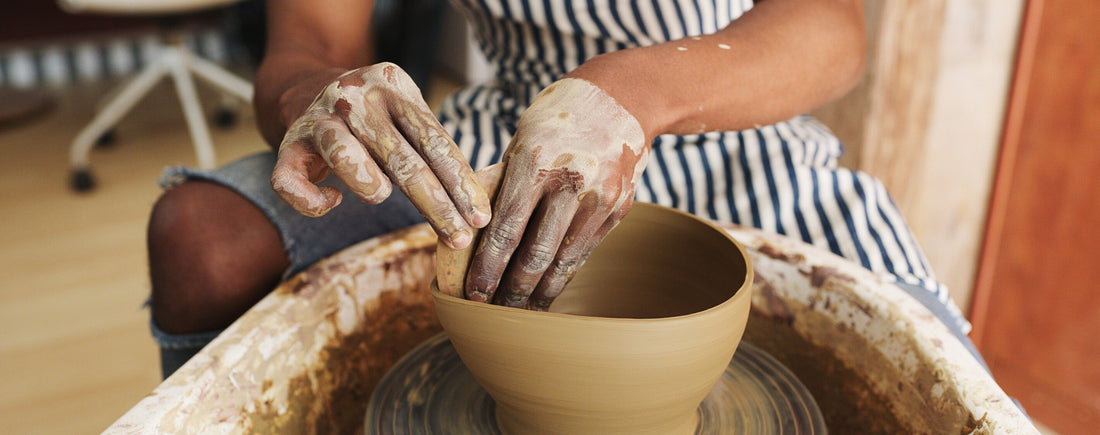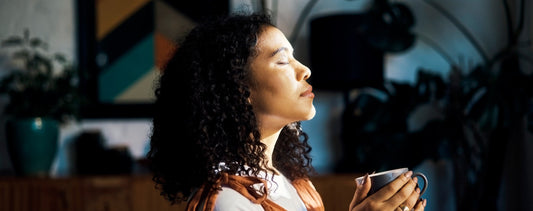There are many ways to bring in the benefits of meditation to everyday life, in addition to a daily practice within. One way is through creating art. Art offers us a deeper connection to ourselves and the inspiration that leads us to our creations sparks greater awareness, too. Art is a powerful vehicle for active meditation because it invites us to experience new levels of acceptance as we express our past, present, and future selves through the creative process.
Art as meditation can include anything from painting a canvas to piecing together a macrame wall hanging to jewelry-making, and more. And, just like meditation, different types of art invite different types of energies in. Ancient art forms such as pottery offer a more grounding art as meditation experience because of the material — clay from the Earth — used and the practice of focusing the mind’s creation and intention with the Earthly elements.
“Doing something like pottery where you can’t really do anything else at the same time, makes it a mindful exercise,” says Sacha Taylor, a yoga instructor and ceramics artist in Los Angeles. “You are singularly focused on it and, in that sense, it makes it like a meditation or mindfulness practice, because it becomes a singular focused activity,” she adds, noting how the act of using our hands and being engaged in creation also brings a sense of alignment.
Unlike other common art forms, pottery also invites us to play with all four natural elements as we create, which helps to ground us and connect us to Mother Earth. From the clay we hold to the water we use when sculpting or at the wheel to the air that dries our creations and, finally, the fire element of the kiln, pottery “goes back to this primal human desire to create things,” explains Taylor. “It’s such a cool opportunity because you take something that is from the Earth and you transform it through your hands and your own imagination into an object,” she adds. “The object doesn’t have to be useful, it’s just something that has meaning to you that you can look at or give as a gift.”
“...you take something that is from the Earth and you transform it through your hands and your own imagination...” Because pottery is all about creating something from nothing, Taylor says it’s “a good practice and training to visualize what you want to create and then use your intention or mind’s eye and hands and body to make something appear basically out of nowhere,” adding “it is very rewarding to see something manifest out of a brick of clay.”
Pottery invites us to release expectations and attachments. When we release these energies, we release judgement, perfectionism, and have less of a focus on the outcome — which allows us to be more present and enjoy the process. Pottery is very fragile and the art of making pottery is a multi-step process with opportunities for mishaps along the way. Because of that, the art invites makers to let go and find meaning in the practice.
Much like meditation, yoga, and other mindfulness practices, Taylor recommends setting yourself up for success to get the most out of this art form. That means, carving out time for creation so that other obligations and responsibilities don’t interfere with your practice. Whether you do pottery at home or in a studio, treating it like you would an exercise or meditation class — where you disconnect from the outside world for a period of time — will allow you to let go and tap into yourself. This invites more awareness and acceptance along the way.
In addition to focusing on the task at hand, there are a few ways to elevate a pottery experience for a more ritualistic and meditative approach. Similar to meditation, playing music might improve the overall experience. If you enjoy listening to music while you meditate, you can try playing yoga or mantra music while you create pottery.
Additionally, Taylor recommends lighting a candle or incense to set the scene and invite more mindfulness into the creative process. You can also begin your pottery process by taking a few deep breaths and setting an intention for your creative process and the pieces you create before getting started.
The mindfulness aspect of pottery doesn’t end with creating pieces from clay. Once the clay is bisque fired and ready for glazing, you can elevate pottery pieces by selecting colors that represent certain energies — such as yellow for happiness and self-confidence, orange for creativity, or green for love. And, focusing your mind on each brushstroke, as well as your relationship to the colors presented to you, can increase levels of mindfulness even more.
• Red: Power, vitality, strength, passion, leadership, desire, courage, success, ambition, love
• Orange: Creativity, confidence, warmth, balance, abundance, vitality, security, fun
• Yellow: Optimism, freedom, inspiration, humor, power, intellect, confidence, joy, open-minded
• Green: Love, generosity, healing, acceptance, balance, harmony, patience, connection to nature
• Blue: Empathy, wisdom, tranquility, self-expression, clarity, trust, calm, peace
• Turquoise: Healing, knowledge, truth, serenity
• Purple: Imaginative, charming, playful, liberal, compassion, spiritual, observant
• Pink: Romance, love, friendship, generosity, health, sympathy
Whether you’re new to pottery or a seasoned thrower, these practices combined with the practice of creating ceramics can strengthen your mind-body connection through a deepened sense of acceptance, connection to the present, and ability to let go and release.
Discover more tools for greater emotional well-being with guided meditations on the Chopra App, available now.
Art as meditation can include anything from painting a canvas to piecing together a macrame wall hanging to jewelry-making, and more. And, just like meditation, different types of art invite different types of energies in. Ancient art forms such as pottery offer a more grounding art as meditation experience because of the material — clay from the Earth — used and the practice of focusing the mind’s creation and intention with the Earthly elements.
Pottery as Meditation
“Doing something like pottery where you can’t really do anything else at the same time, makes it a mindful exercise,” says Sacha Taylor, a yoga instructor and ceramics artist in Los Angeles. “You are singularly focused on it and, in that sense, it makes it like a meditation or mindfulness practice, because it becomes a singular focused activity,” she adds, noting how the act of using our hands and being engaged in creation also brings a sense of alignment.
Unlike other common art forms, pottery also invites us to play with all four natural elements as we create, which helps to ground us and connect us to Mother Earth. From the clay we hold to the water we use when sculpting or at the wheel to the air that dries our creations and, finally, the fire element of the kiln, pottery “goes back to this primal human desire to create things,” explains Taylor. “It’s such a cool opportunity because you take something that is from the Earth and you transform it through your hands and your own imagination into an object,” she adds. “The object doesn’t have to be useful, it’s just something that has meaning to you that you can look at or give as a gift.”
Pottery invites us to release expectations and attachments. When we release these energies, we release judgement, perfectionism, and have less of a focus on the outcome — which allows us to be more present and enjoy the process. Pottery is very fragile and the art of making pottery is a multi-step process with opportunities for mishaps along the way. Because of that, the art invites makers to let go and find meaning in the practice.
The Practice of Pottery
Much like meditation, yoga, and other mindfulness practices, Taylor recommends setting yourself up for success to get the most out of this art form. That means, carving out time for creation so that other obligations and responsibilities don’t interfere with your practice. Whether you do pottery at home or in a studio, treating it like you would an exercise or meditation class — where you disconnect from the outside world for a period of time — will allow you to let go and tap into yourself. This invites more awareness and acceptance along the way.
In addition to focusing on the task at hand, there are a few ways to elevate a pottery experience for a more ritualistic and meditative approach. Similar to meditation, playing music might improve the overall experience. If you enjoy listening to music while you meditate, you can try playing yoga or mantra music while you create pottery.
Additionally, Taylor recommends lighting a candle or incense to set the scene and invite more mindfulness into the creative process. You can also begin your pottery process by taking a few deep breaths and setting an intention for your creative process and the pieces you create before getting started.
The mindfulness aspect of pottery doesn’t end with creating pieces from clay. Once the clay is bisque fired and ready for glazing, you can elevate pottery pieces by selecting colors that represent certain energies — such as yellow for happiness and self-confidence, orange for creativity, or green for love. And, focusing your mind on each brushstroke, as well as your relationship to the colors presented to you, can increase levels of mindfulness even more.
The Energy of Color:
• Red: Power, vitality, strength, passion, leadership, desire, courage, success, ambition, love
• Orange: Creativity, confidence, warmth, balance, abundance, vitality, security, fun
• Yellow: Optimism, freedom, inspiration, humor, power, intellect, confidence, joy, open-minded
• Green: Love, generosity, healing, acceptance, balance, harmony, patience, connection to nature
• Blue: Empathy, wisdom, tranquility, self-expression, clarity, trust, calm, peace
• Turquoise: Healing, knowledge, truth, serenity
• Purple: Imaginative, charming, playful, liberal, compassion, spiritual, observant
• Pink: Romance, love, friendship, generosity, health, sympathy
Whether you’re new to pottery or a seasoned thrower, these practices combined with the practice of creating ceramics can strengthen your mind-body connection through a deepened sense of acceptance, connection to the present, and ability to let go and release.
Discover more tools for greater emotional well-being with guided meditations on the Chopra App, available now.






















